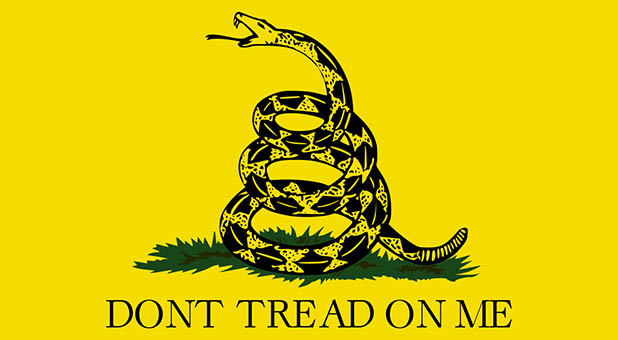Is This Symbol of American Freedom Racist?
In 1775, Charles Gadsden, a member of the South Carolina Congress, the Continental Congress, and the Marine Committee commissioned to help form the first United States Navy, presented Commodore Esek Hopkins with a special ensign for his flagship.
As was described by the South Carolina Congress—which also received a copy of the flag—it was “being a yellow field, with a lively representation of a rattlesnake in the middle in the attitude of going to strike and these words underneath, ‘Don’t tread on me.'” Today, we know this flag simply as “The Gadsden Flag.”
During the Revolutionary War, it was one of two “motto flags” used by American Marines. Today, it’s become a symbol of libertarians and members of the tea party movement.
But apparently to some, it is a symbol of racism.
According to a complaint filed with the Equal Employment Opportunity Commission, one worker’s wearing of a hat that depicts the Gadsden Flag was considered “racially offensive” because Christopher Gadsden owned slaves. The complainant in that case maintained the Gadsden Flag was a “historical indicator of white resentment against blacks stemming largely from the Tea Party.”
The EEOC, according to The Washington Post, found:
After a thorough review of the record, it is clear that the Gadsden Flag originated in the Revolutionary War in a non-racial context. Moreover, it is clear that the flag and its slogan have been used to express various non-racial sentiments, such as when it is used in the modern Tea Party political movement, guns rights activism, patriotic displays, and by the military.
But, the EEOC also found two instances—only two—in the past two years where the Gadsden Flag was “interpreted to convey racially-tinged messages in some contexts.” So, it wanted to investigate the meaning behind why the co-worker was wearing the hat with the Gadsden Flag before deciding whether or not it conveyed racism:
In light of the ambiguity in the current meaning of this symbol, we find that Complainant’s claim must be investigated to determine the specific context in which C1 displayed the symbol in the workplace. In so finding, we are not prejudging the merits of Complainant’s complaint. Instead, we are precluding a procedural dismissal that would deprive us of evidence that would illuminate the meaning conveyed by C1’s display of the symbol.
The EEOC is a taxpayer funded entity of the federal government, tasked with, among other things, deciding the outcome of “hostile work environment” harassment claims brought against employers. In doing so, it applies the same legal rules that courts apply in civil litigation.







































